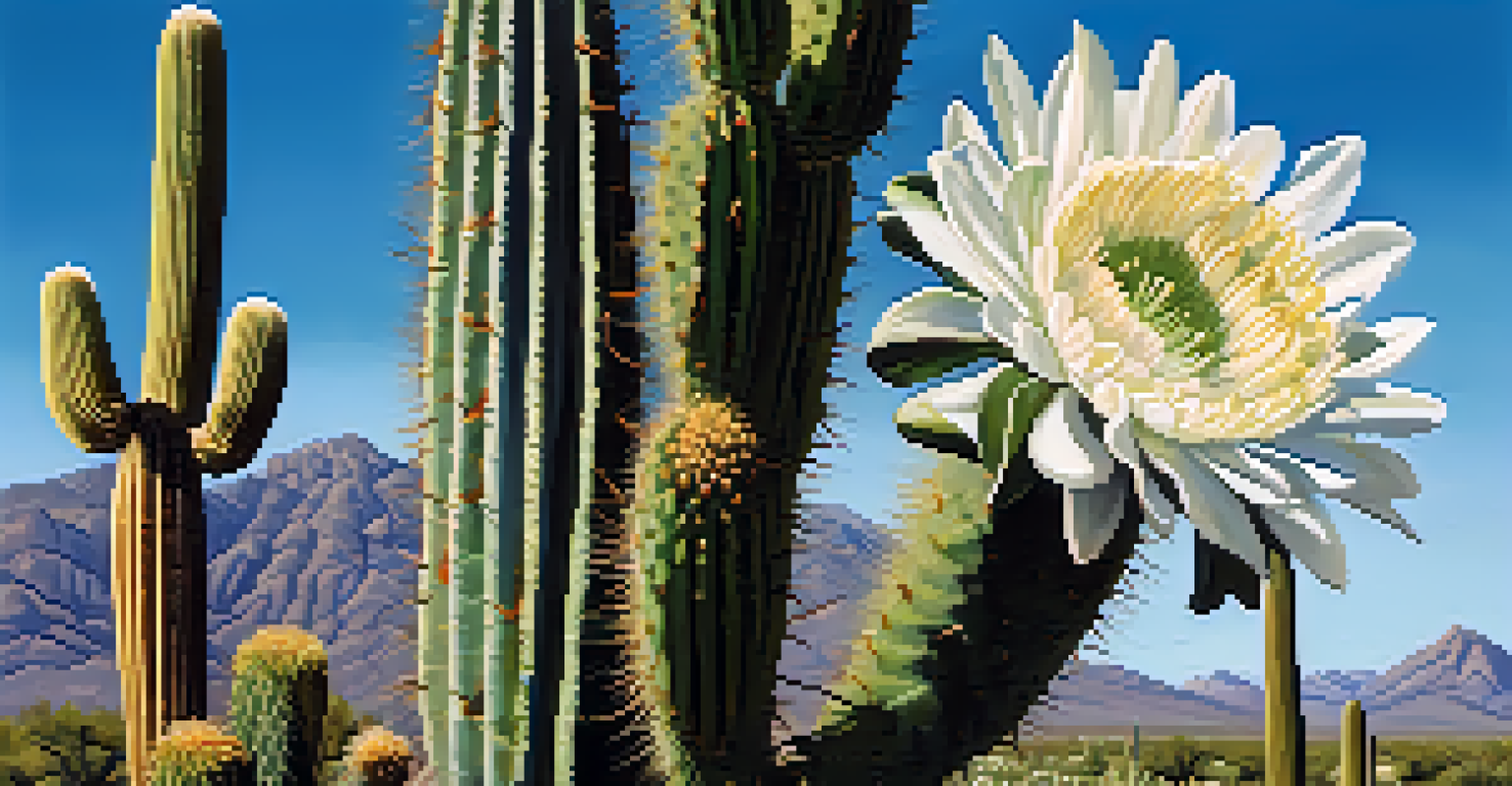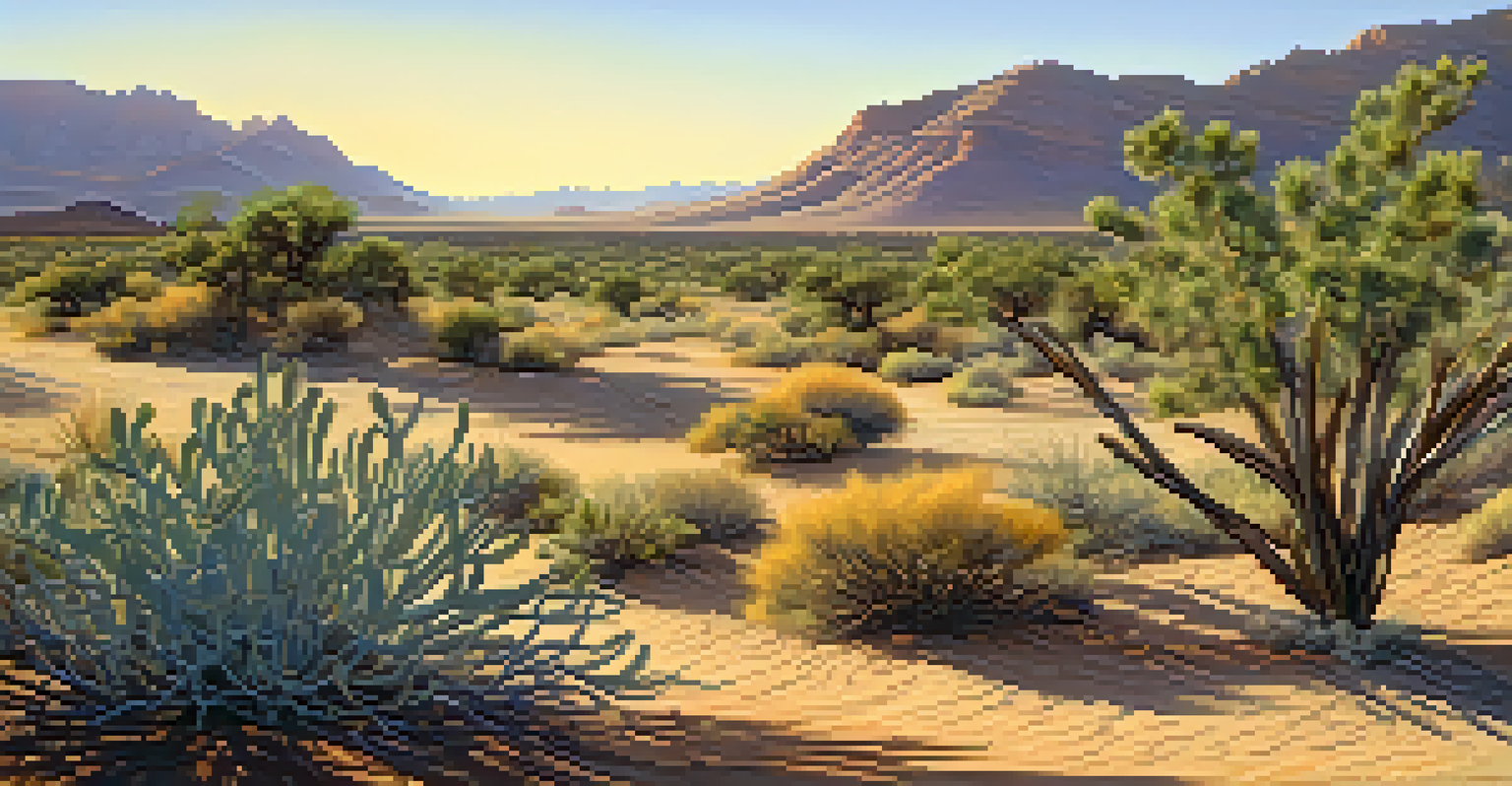Tucson's Desert Flora: Resilience in Harsh Conditions Explained

Understanding Tucson's Unique Desert Environment
Tucson, Arizona, is known for its breathtaking desert landscapes, characterized by arid climates, extreme temperatures, and minimal rainfall. This unique environment creates a challenging habitat for most living organisms. However, the flora in this region has adapted remarkably to these harsh conditions, showcasing resilience that is both fascinating and inspiring.
In every walk with nature one receives far more than he seeks.
The Sonoran Desert, where Tucson is located, experiences temperatures that can soar above 100°F in summer and dip below freezing in winter. Despite the harsh climate, plants have evolved survival strategies that allow them to thrive where others cannot. From cacti to wildflowers, each species has its own set of adaptations that contribute to the desert's biodiversity.
Understanding the environmental factors at play is crucial to appreciating how Tucson's desert flora has flourished. These plants are not just surviving; they are thriving, creating an ecosystem that supports a variety of wildlife and contributes to the overall health of the region.
The Role of Cacti in Desert Ecosystems
Cacti are perhaps the most iconic representatives of Tucson's desert flora. These succulent plants have evolved to store water in their thick, fleshy tissues, enabling them to endure long periods of drought. Their unique adaptations, such as spines instead of leaves, help reduce water loss and protect them from herbivores.

In addition to their survival strategies, cacti play a vital role in the desert ecosystem. They provide crucial resources for various animals, including food, shelter, and nesting sites. For example, the saguaro cactus is home to several bird species, while its flowers offer nectar to pollinators like bees and bats.
Tucson's Flora Thrives in Harshness
The unique desert environment of Tucson fosters remarkable adaptations in flora, enabling them to flourish despite extreme conditions.
Cacti also contribute to the soil and atmosphere, helping to prevent erosion and improve air quality. As they grow and die, they enrich the soil with organic matter, promoting a healthy environment for other plants and animals, thus showcasing their integral role in the desert ecosystem.
Adaptations of Desert Wildflowers
Desert wildflowers, often overlooked, demonstrate remarkable resilience in Tucson's sandy soils. These plants have developed specific strategies to thrive amidst scarce resources. For instance, many wildflowers have deep taproots that reach moisture buried far beneath the surface, allowing them to survive even during prolonged dry spells.
The clearest way into the Universe is through a forest wilderness.
Moreover, the beauty of these wildflowers often appears suddenly after rainfall, transforming the desert floor into a vibrant tapestry of colors. This phenomenon is known as a 'desert bloom' and is a testament to their survival tactics. The timing of their blooming is often synchronized with seasonal rains, ensuring that their seeds can germinate and grow at the most favorable times.
These adaptations not only allow wildflowers to survive but also contribute to the ecosystem's overall health. By attracting pollinators and enriching the soil with their decaying leaves, they help sustain other plant and animal life in the desert, proving that even the most delicate flowers can thrive in tough conditions.
The Importance of Drought-Resistant Shrubs
Drought-resistant shrubs are another vital component of Tucson's desert flora. Species like creosote bush and mesquite have evolved to withstand the arid climate by developing extensive root systems that can tap into deep moisture sources. This ability not only helps them survive but also supports surrounding plant life.
These shrubs also play critical roles in soil stabilization and nutrient cycling. Their roots help prevent erosion, while their decaying leaves enrich the soil, making it more hospitable for other plants. In this way, drought-resistant shrubs act as guardians of the desert landscape, ensuring that it remains vibrant and productive.
Cacti: Essential Desert Ecosystem
Cacti play a crucial role in Tucson's ecosystem by providing food, shelter, and contributing to soil health.
Furthermore, many desert shrubs provide food and shelter for wildlife. Birds, insects, and small mammals depend on these plants for survival, creating a rich tapestry of life in the seemingly barren desert. Thus, the presence of these resilient shrubs is crucial for maintaining the ecological balance in Tucson's harsh environment.
How Desert Plants Manage Water Conservation
Water conservation is a paramount concern for plants in Tucson's desert. To survive, many desert species have evolved unique strategies to minimize water loss. For instance, some plants have developed a waxy coating on their leaves, which helps reduce evaporation—a clever adaptation that allows them to maintain hydration in extreme heat.
Additionally, many desert plants utilize a process called CAM (Crassulacean Acid Metabolism) photosynthesis, which enables them to open their stomata at night instead of during the hot day. This means they can take in carbon dioxide while minimizing water loss, effectively allowing them to thrive in an environment where water is scarce.
These water conservation mechanisms not only help individual plants survive but also ensure that the entire ecosystem can function effectively. By maintaining moisture levels in the soil and atmosphere, desert plants create a more stable environment for themselves and for the myriad of creatures that depend on them.
The Impact of Climate Change on Desert Flora
Climate change poses significant challenges to Tucson's desert flora, altering the delicate balance these plants have maintained for centuries. Rising temperatures and shifting precipitation patterns can disrupt the life cycles of many plant species, potentially threatening their survival. For example, some plants may struggle to adapt to the new conditions, leading to a decline in biodiversity.
Moreover, increased frequency and intensity of droughts can further stress these already resilient plants. While many desert species are well-equipped to handle arid conditions, prolonged drought can push them beyond their limits. As a result, understanding the potential impacts of climate change is crucial for conservation efforts.
Conservation Efforts Are Vital
Ongoing conservation initiatives are essential to protect Tucson's diverse desert flora amidst challenges like climate change.
Efforts to protect and restore Tucson's desert flora are more important than ever. By promoting sustainable practices and raising awareness about the significance of these plants, we can help ensure that this unique ecosystem continues to thrive despite the challenges posed by climate change.
Conservation Efforts for Tucson's Unique Flora
Conservation efforts are essential to safeguarding Tucson's unique desert flora for future generations. Organizations and local communities are actively engaged in initiatives aimed at preserving the delicate balance of this ecosystem. From habitat restoration projects to educational programs, these efforts highlight the importance of protecting our natural heritage.
One notable initiative is the establishment of protected areas and botanical gardens that showcase and conserve native plant species. These spaces not only serve as a refuge for endangered plants but also provide opportunities for research and education, fostering a deeper appreciation for the incredible resilience of desert flora.

In addition, community involvement plays a crucial role in conservation. By participating in local planting events or spreading awareness about the significance of native plants, individuals can make a tangible impact. Together, we can ensure that Tucson's desert flora continues to thrive, reminding us of the beauty and resilience found in even the harshest conditions.